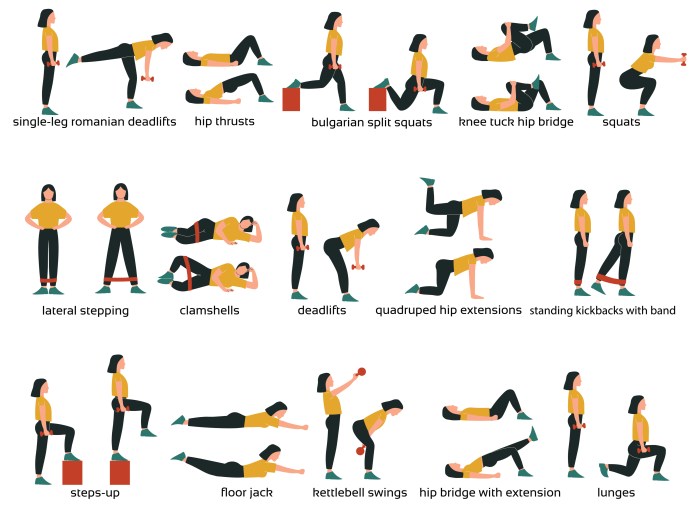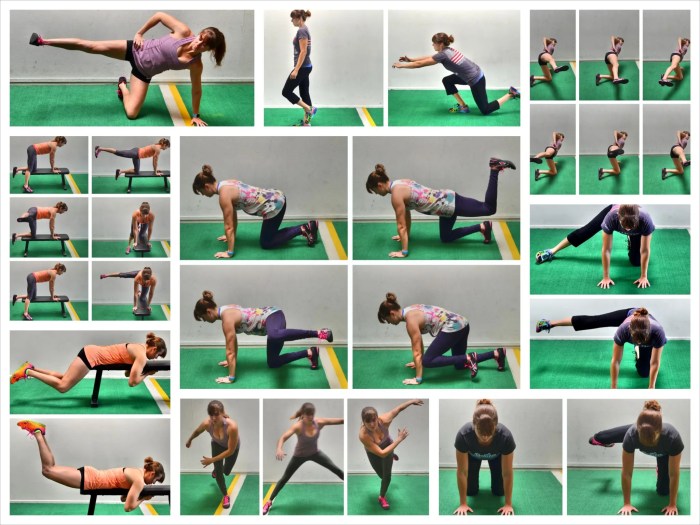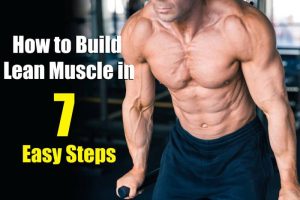
Ready to unlock the power of your glutes and transform your lower body? Strong glutes are the foundation of athleticism, functional movement, and a sculpted physique. From explosive jumps to everyday activities like walking and climbing stairs, your glutes play a crucial role. This guide delves into the anatomy of your glutes, reveals the most effective exercises for strength and growth, and provides expert tips for proper form, injury prevention, and maximizing your results.
We’ll explore a range of exercises suitable for all fitness levels, from beginners to seasoned athletes. You’ll learn how to build a balanced lower body workout that targets all the major muscle groups, including quads, hamstrings, and calves. Plus, we’ll uncover the secrets to optimal nutrition and recovery for achieving your fitness goals.
Essential Glute Exercises for Strength and Growth
Strengthening your glutes is crucial for a strong lower body, enhancing athletic performance, and reducing the risk of injuries. Targeting your glutes with effective exercises can help you build muscle, improve power, and enhance your overall fitness.
Essential Glute Exercises
These exercises are fundamental for building strong and powerful glutes. They can be incorporated into various workout routines and are suitable for both beginners and advanced individuals.
| Exercise | Description | Target Muscles | Variations |
|---|---|---|---|
| Hip Thrust | Lie on your back with your feet flat on the floor, hip-width apart. Place a bench or a weight plate across your hips. Push through your heels to lift your hips off the ground until your body forms a straight line from your shoulders to your knees. Slowly lower your hips back down to the starting position. | Glutes, hamstrings, and lower back | Barbell hip thrust, single-leg hip thrust, band-assisted hip thrust |
| Glute Bridge | Lie on your back with your knees bent and feet flat on the floor. Lift your hips off the ground, squeezing your glutes at the top. Hold for a few seconds before slowly lowering your hips back down. | Glutes, hamstrings, and core | Single-leg glute bridge, glute bridge with band, glute bridge with weight plate |
| Squat | Stand with your feet shoulder-width apart, toes slightly pointed out. Lower your hips as if you’re sitting in a chair, keeping your back straight and core engaged. Push through your heels to stand back up. | Glutes, quads, hamstrings, and calves | Goblet squat, front squat, back squat, overhead squat, pistol squat |
| Lunge | Step forward with one leg, bending both knees to a 90-degree angle. Ensure your front knee stays behind your toes and your back knee stays close to the ground. Push off with your front foot to return to the starting position. | Glutes, quads, hamstrings, and calves | Walking lunge, stationary lunge, reverse lunge, jump lunge |
| Deadlift | Stand with your feet hip-width apart, facing a barbell. Bend down and grasp the barbell with an overhand grip, slightly wider than shoulder-width. Keep your back straight and core engaged. Lift the barbell off the ground, extending your hips and knees. Slowly lower the barbell back to the ground. | Glutes, hamstrings, lower back, and traps | Conventional deadlift, Romanian deadlift, sumo deadlift, trap bar deadlift |
Advanced Glute Exercises
These exercises are more challenging and require a higher level of strength and coordination. They can help you further activate and strengthen your glutes.
| Exercise | Description | Target Muscles | Variations |
|---|---|---|---|
| Bulgarian Split Squat | Stand with one foot on a bench or platform, and the other foot flat on the ground. Lower your body down until your front knee is bent at a 90-degree angle. Push off with your front foot to return to the starting position. | Glutes, quads, hamstrings, and calves | Single-leg Bulgarian split squat, Bulgarian split squat with weight plate |
| Single-Leg Deadlift | Stand with your feet hip-width apart. Hinge forward at the hips, keeping your back straight and core engaged. Lower your torso towards the ground, keeping your back leg straight. Drive through your heel to stand back up. | Glutes, hamstrings, and lower back | Single-leg deadlift with dumbbell, single-leg deadlift with kettlebell |
| Glute Kickback | Kneel on all fours, with your knees hip-width apart and your hands shoulder-width apart. Extend one leg back, keeping your knee slightly bent. Squeeze your glutes as you extend your leg, and slowly lower it back to the starting position. | Glutes and hamstrings | Glute kickback with band, glute kickback with cable machine |
Proper Form and Technique
Proper form and technique are crucial for maximizing glute activation and preventing injuries during exercises. Focusing on proper form ensures that the target muscles are working effectively, while minimizing the risk of strain or overuse of other muscle groups.
Importance of Proper Form
Proper form is essential for effective glute activation. It ensures that the target muscles are working correctly and that the exercise is performed safely. When proper form is maintained, the glutes are the primary muscles engaged, leading to increased muscle activation and better results.
- Reduced Risk of Injury: Proper form helps distribute the load appropriately, minimizing stress on joints and ligaments. This reduces the risk of injuries such as lower back pain, knee pain, or hamstring strains.
- Enhanced Muscle Activation: When performed correctly, glute exercises target the glutes effectively, maximizing muscle activation and promoting muscle growth. This leads to stronger glutes and a more balanced lower body.
- Improved Performance: Proper form optimizes movement patterns, enhancing efficiency and power during exercises. This translates to better performance in other activities, including running, jumping, and lifting.
Common Mistakes to Avoid
Understanding common mistakes can help you refine your technique and achieve optimal results.
- Arching the Back: This puts excessive stress on the lower back and can lead to injury. It’s crucial to maintain a neutral spine throughout the exercise.
- Not Engaging the Core: A weak core can lead to improper form and increased risk of injury. Actively engage your core muscles throughout the exercise to stabilize your body.
- Using Momentum: Relying on momentum instead of controlled movements can reduce glute activation and increase the risk of injury. Focus on slow and controlled movements.
- Not Reaching Full Range of Motion: Failing to reach the full range of motion reduces muscle activation and limits the effectiveness of the exercise. Ensure a full range of motion during each repetition.
- Going Too Heavy: Lifting weights that are too heavy can compromise form and increase the risk of injury. Start with a weight that allows you to maintain proper form and gradually increase the weight as you get stronger.
Building a Balanced Lower Body Workout
Building a strong lower body involves targeting all the major muscle groups, not just your glutes. A balanced approach ensures overall strength, stability, and functionality.
Sample Lower Body Workout Routine
A well-rounded lower body workout routine incorporates exercises for quads, hamstrings, glutes, and calves. Here’s a sample routine you can follow:
- Warm-up (5-10 minutes):
- Light cardio, like jogging in place or jumping jacks
- Dynamic stretching, such as leg swings, hip circles, and torso twists
- Workout (3-4 sets of 8-12 repetitions for each exercise):
- Quads:
- Barbell Squats
- Leg Press
- Hamstrings:
- Romanian Deadlifts
- Hamstring Curls
- Glutes:
- Hip Thrusts
- Glute Bridges
- Bulgarian Split Squats
- Calves:
- Calf Raises
- Donkey Calf Raises
- Quads:
- Cool-down (5-10 minutes):
- Static stretching, holding each stretch for 30 seconds
Remember to focus on proper form and technique throughout your workout. This will ensure that you’re working the intended muscles effectively and minimizing the risk of injury.
Nutrition and Recovery for Optimal Results
You’ve been diligently working out, challenging your glutes with effective exercises, but maximizing your results goes beyond just training. Your body needs the right fuel and rest to rebuild muscle fibers, enhance strength, and promote growth. Let’s delve into the crucial role of nutrition and recovery in optimizing your glute gains.
Importance of a Balanced Diet for Muscle Growth and Recovery
A balanced diet is the foundation for muscle growth and recovery. It provides the essential nutrients your body needs to repair muscle tissue after workouts, synthesize new muscle protein, and support overall health.
Foods That Support Muscle Building and Recovery
Here’s a list of foods that are particularly beneficial for muscle building and recovery:
- Protein: Protein is the building block of muscle tissue. Aim to consume 1.6-2.2 grams of protein per kilogram of body weight daily.
- Lean meats: Chicken, turkey, fish, beef
- Eggs: A complete protein source
- Dairy: Milk, yogurt, cheese
- Plant-based protein sources: Tofu, tempeh, lentils, beans, quinoa
- Carbohydrates: Carbs provide energy for workouts and help replenish glycogen stores, which are essential for muscle recovery.
- Complex carbohydrates: Whole grains, brown rice, sweet potatoes, fruits, vegetables
- Healthy Fats: Healthy fats support hormone production, which is important for muscle growth and recovery.
- Unsaturated fats: Olive oil, avocado, nuts, seeds
Role of Sleep and Hydration in Optimizing Results
- Adequate Sleep: Sleep is crucial for muscle repair and growth. During sleep, your body releases growth hormone, which is essential for muscle building. Aim for 7-9 hours of quality sleep each night.
- Hydration: Water is essential for muscle function and recovery. It helps transport nutrients to your muscles, removes waste products, and regulates body temperature. Aim to drink plenty of water throughout the day, especially before, during, and after workouts.
Food and Related Products

Fueling your body with the right nutrients is crucial for muscle growth and recovery. A well-balanced diet that prioritizes protein, carbohydrates, and healthy fats will provide the building blocks your muscles need to rebuild and grow stronger.
Food and Related Products for Muscle Growth and Recovery
A balanced diet is essential for muscle growth and recovery. Here’s a breakdown of food groups and related products that support these processes:
| Category | Food and Related Products | Benefits | Examples |
|---|---|---|---|
| Protein Sources | Lean meats, poultry, fish, eggs, dairy products, tofu, tempeh, legumes, quinoa, nuts, seeds | Provide amino acids necessary for muscle protein synthesis and repair. | Chicken breast, salmon, Greek yogurt, edamame, almonds |
| Carbohydrates | Whole grains, fruits, vegetables, sweet potatoes, brown rice, oats | Provide energy for workouts and replenish glycogen stores. | Quinoa, bananas, broccoli, sweet potatoes |
| Healthy Fats | Avocado, olive oil, nuts, seeds, fatty fish | Support hormone production, reduce inflammation, and improve recovery. | Avocados, salmon, walnuts, chia seeds |
| Supplements | Creatine, protein powder, glutamine, BCAAs | May enhance performance, muscle growth, and recovery, but should be used in moderation and under professional guidance. | Creatine monohydrate, whey protein, glutamine powder, BCAA capsules |
Product Creation
Building a strong lower body requires dedication and the right tools. Here are some product ideas that can enhance your glute training and lower body strength journey.
Workout Equipment
Workout equipment can significantly enhance your glute exercises and lower body strength development. Here are some examples:
- Resistance Bands: Resistance bands offer versatile resistance for a variety of glute exercises, including hip thrusts, glute bridges, and band walks. They provide adjustable resistance, making them suitable for different fitness levels. Resistance bands are compact, portable, and affordable, making them ideal for home workouts.
- Kettlebells: Kettlebells are versatile weights that can be used for a wide range of exercises, including squats, lunges, and swings. They challenge your core and improve coordination, contributing to overall lower body strength.
- Adjustable Dumbbells: Adjustable dumbbells allow you to easily change weight for different exercises, making them convenient for home workouts. They can be used for various exercises, including squats, lunges, and deadlifts, targeting your glutes and other lower body muscles.
Clothing
The right clothing can enhance your workout experience and provide support for your lower body.
- Compression Leggings: Compression leggings provide support and enhance blood flow, potentially reducing muscle fatigue and soreness. They can also improve your range of motion and stability, contributing to better performance during glute exercises.
- High-Waisted Shorts: High-waisted shorts offer extra support and coverage for your glutes and lower abdomen. They are ideal for exercises like squats and lunges, providing a secure fit that allows for a full range of motion.
Supplements
Supplements can support your overall fitness goals and help you achieve optimal results.
- Creatine: Creatine is a popular supplement that can enhance muscle growth and strength. It increases muscle phosphocreatine stores, which provide energy for high-intensity exercises. Creatine can be beneficial for building lower body strength and achieving better results in glute exercises.
- Protein Powder: Protein powder is a convenient way to increase your protein intake, which is crucial for muscle repair and growth. It can be beneficial for building and maintaining muscle mass, supporting your lower body strength development.
Bed Breakfast Inns
Bed and breakfast inns, known for their cozy atmosphere and personalized service, can create a unique fitness experience for guests by incorporating glute exercises into their offerings. This strategy can attract a new clientele interested in wellness and provide an opportunity for differentiation in a competitive market.
Fitness Programs and Amenities
Offering fitness programs can enhance the guest experience at bed and breakfast inns. These programs can be tailored to different fitness levels and interests, including:
- Glute-Focused Workouts: Incorporate exercises like squats, lunges, and hip thrusts into guided sessions, providing guests with a structured workout experience.
- Yoga and Pilates Classes: These disciplines often emphasize core strength and flexibility, which can be beneficial for glute development.
- Outdoor Activities: Hiking, biking, or even guided walks can engage the glutes and provide a scenic and enjoyable workout.
Marketing and Branding
To effectively market these fitness offerings, bed and breakfast inns can utilize various strategies:
- Website and Social Media: Highlight fitness programs and amenities on the inn’s website and social media platforms, showcasing the benefits of a healthy stay.
- Targeted Advertising: Reach potential guests interested in fitness by using targeted advertising campaigns on platforms like Google Ads or Facebook.
- Partnerships: Collaborate with local fitness instructors, gyms, or wellness centers to offer joint promotions and packages.
Cooking and Culinary

Fueling your body with the right nutrients is crucial for building muscle and supporting recovery after intense lower body workouts. This means prioritizing protein-rich foods, healthy fats, and complex carbohydrates to help your muscles rebuild and grow stronger. Here are some tips for incorporating these essential nutrients into your diet.
Healthy Recipes for Muscle Growth and Recovery
A balanced diet is essential for optimal muscle growth and recovery. Here are some recipes that incorporate protein, healthy fats, and complex carbohydrates:
Protein-Rich Meals
- Grilled Salmon with Roasted Vegetables: Salmon is a great source of protein and omega-3 fatty acids, which are important for muscle recovery. Pair it with roasted vegetables like broccoli, asparagus, or Brussels sprouts for a complete and nutritious meal.
- Chicken Breast with Quinoa and Black Beans: Chicken breast is a lean protein source, while quinoa provides complex carbohydrates and black beans offer fiber and other essential nutrients. This meal is perfect for post-workout recovery.
- Lentil Soup with Whole Wheat Bread: Lentils are a powerhouse of protein and fiber, making them a great option for a hearty and healthy meal. Serve with a slice of whole wheat bread for added carbohydrates.
Muscle-Building Snacks
- Greek Yogurt with Berries and Nuts: Greek yogurt is a high-protein snack that also provides calcium and probiotics for gut health. Add berries for antioxidants and nuts for healthy fats.
- Hard-Boiled Eggs: Eggs are a complete protein source, meaning they contain all the essential amino acids your body needs. They are also a good source of vitamins and minerals.
- Trail Mix with Protein Powder: Combine your favorite nuts, seeds, and dried fruit with protein powder for a quick and easy snack that provides protein, healthy fats, and carbohydrates.
Tips for Preparing Nutritious and Delicious Meals
- Plan your meals in advance: This will help you make healthier choices and avoid grabbing unhealthy snacks when you’re short on time.
- Cook at home more often: This gives you control over the ingredients and portion sizes.
- Use fresh, whole ingredients: These are packed with nutrients and flavor.
- Experiment with different spices and herbs: This can add flavor to your meals without adding extra calories or fat.
- Don’t be afraid to get creative in the kitchen: There are endless possibilities when it comes to healthy and delicious meals.
By incorporating these effective exercises into your routine and focusing on proper form, you’ll unlock the potential of your glutes and build a strong, functional, and aesthetically pleasing lower body. Remember, consistency is key. Embrace the journey, celebrate your progress, and enjoy the benefits of powerful glutes that empower your every move.
Query Resolution
What are the best glute exercises for beginners?
For beginners, focus on exercises that emphasize proper form and technique. Start with bodyweight exercises like glute bridges, hip thrusts, and squats. As you progress, you can incorporate weights and resistance bands for added challenge.
How often should I train my glutes?
Aim for 2-3 glute workouts per week, allowing for adequate rest and recovery between sessions. This allows your muscles to repair and rebuild, leading to greater strength and growth.
What are some common mistakes to avoid during glute exercises?
Common mistakes include using momentum instead of controlled movement, arching the back excessively, and not fully engaging the glutes. Focus on proper form, maintaining a neutral spine, and squeezing your glutes at the top of each rep.






